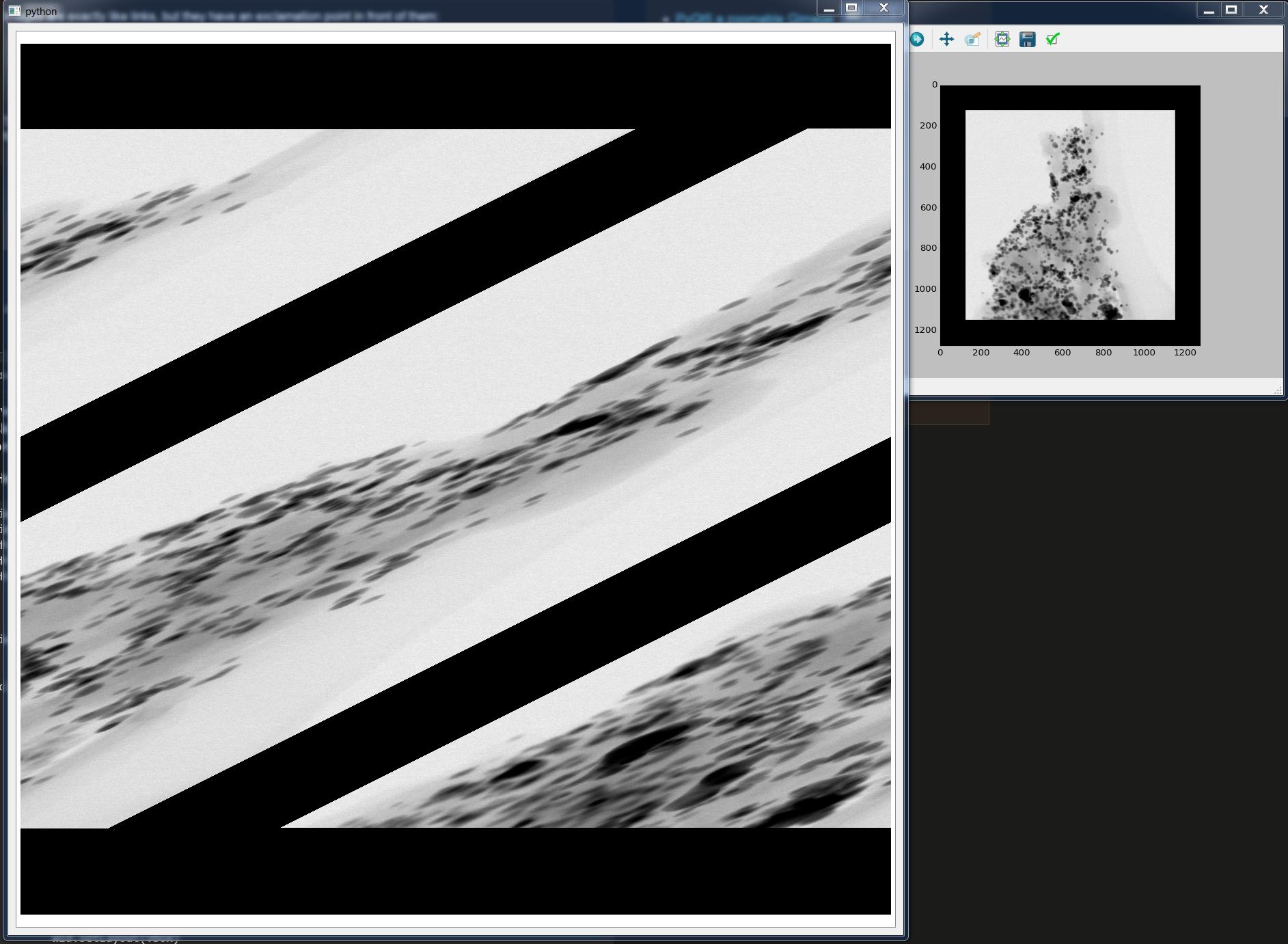I'm working with tif stacks and QImage appears to be skewing some images to a 45 degree angle. Matplotlib is able to display the images without a problem in both test cases (links to two tif stacks are provided below) so I don't think I've screwed up my array somewhere.
Here's a working example: (NOTE: this example only shows the first image in the tif stack for simplicity)
import matplotlib.pyplot as plt
import sys
from PIL import Image
from PyQt5.QtGui import QPixmap, QImage
from PyQt5.QtWidgets import (QMainWindow, QApplication, QVBoxLayout,
QWidget, QFileDialog, QGraphicsPixmapItem, QGraphicsView,
QGraphicsScene)
import numpy as np
class Example(QMainWindow):
def __init__(self):
super().__init__()
self.initUI()
def initUI(self):
# set up a widget to hold a pixmap
wid = QWidget(self)
self.setCentralWidget(wid)
self.local_grview = QGraphicsView()
self.local_scene = QGraphicsScene()
vbox = QVBoxLayout()
self.local_grview.setScene( self.local_scene )
vbox.addWidget(self.local_grview)
wid.setLayout(vbox)
# load and display the image
self.loadImage()
# display the widget
self.show()
# also use matplotlib to display the data as it should appear
plt.imshow(self.dataUint8[0], cmap='gray')
plt.show()
def loadImage(self):
fname = QFileDialog.getOpenFileName(self, 'Open file', '/home')[0]
# use the tif reader to read in the tif stack
self.data = self.readTif(fname)
# convert to uint8 for display
self.dataUint8 = self.uint8Convert(self.data)
###############################################################################################################################
# I suspect this is where something goes wrong
###############################################################################################################################
# create a QImage object
self.im = QImage(self.dataUint8[0], self.dataUint8[0].shape[1], self.dataUint8[0].shape[0], QImage.Format_Grayscale8)
# if we save using self.im.save() we also have a skewed image
###############################################################################################################################
# send the QImage object to the pixmap generator
self.pixmap = QPixmap(self.im)
self.pixMapItem = QGraphicsPixmapItem(self.pixmap, None)
self.local_scene.addItem(self.pixMapItem)
def readTif(self, filename): # use this function to read in a tif stack and return a 3D numpy array
# read in the file
stack = Image.open(filename)
# extract each frame from the file and store in the frames variable
frames = []
i = 0
while True:
try:
stack.seek(i) # move to the ith position in the stack
frames.append(np.array(stack) )
i += 1
except EOFError:
# end of stack
break
del stack # probably unnecessary but this presumably saves a bit of memory
return frames
def uint8Convert(self, frames): # use this function to scale a 3D numpy array of floats to 0-255 so it plays well with Qt methods
# convert float array to uint8 array
if np.min(frames)<0:
frames_uint8 = [np.uint8((np.array(frames[i]) - np.min(frames[i]))/np.max(frames[i])*255) for i in range(np.shape(frames)[0])]
else:
frames_uint8 = [np.uint8(np.array(frames[i])/np.max(frames[i])*255) for i in range(np.shape(frames)[0])]
return frames_uint8
if __name__=='__main__':
app = QApplication(sys.argv)
ex = Example()
sys.exit(app.exec_())
Here's a screenshot of the output:
Qimage vs matplotlib
Here's a link to a tif stack that displays properly:
https://drive.google.com/uc?export=download&id=0B9EG5AHWC9qzX3NrNTJRb2toV2c
And here's a link to a tif stack that becomes skewed when displayed:
https://drive.google.com/uc?export=download&id=0B9EG5AHWC9qzbFB4TDU4c2x1OE0
Any help understanding why QImage is skewing this image would be much appreciated. The only major difference between the two tif stacks is that the one that displays skewed has a padded black area (zeros) around the image which makes the array larger.
UPDATE: I've now discovered that if I crop the offending image to 1024x1024 or 512x512 or 1023x1024 QImage displays properly but cropping by 1024x1023 displays skewed. So it appears that the x (horizontal) length must be a power of 2 in order for QImage to handle it as expected. That's a ridiculous limitation! There must be something I'm not understanding. Surely there's a way for it to handle arbitrarily shaped arrays.
...I suppose, in principle, one could first apply a skew to the image and just let QImage deskew it back... (<== not a fan of this solution)


self.im = QImage(fname)indeed displays properly! But how do I then access the other images in the stack? It appears thatQImageonly reads in the first image. – BuildQImageto display properly, then that means I have to write the data to disk and read it back in every time I want to update the image. – Build